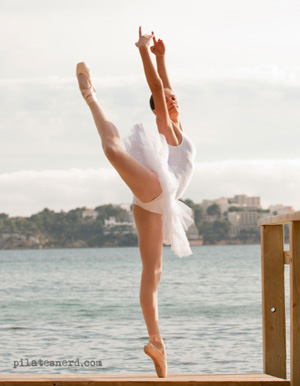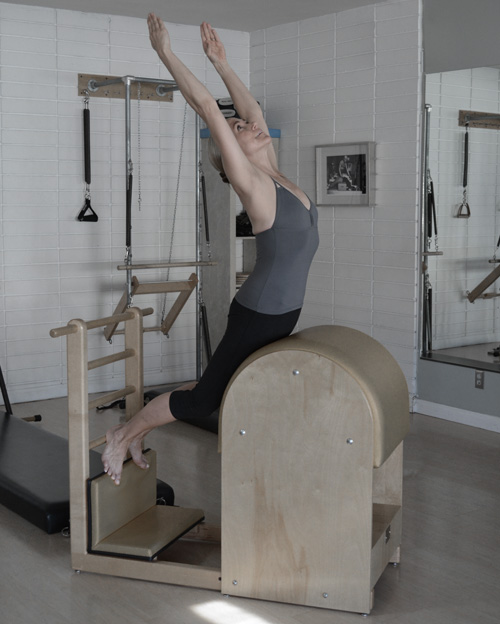By Karen Ellis
It happened again. I was in a Mat class recently and I got frustrated -even sad- that I couldn’t do a few exercises well. Namely, the extension type.
However if there’s ONE thing I’ve learned over the years, it’s that in the Pilates repertoire, there exist a few exercises that just aren’t ideal for the BODY at hand. My ego doesn’t care; I yearn to ‘dance’ with the Rock Stars in the class…and the one in my head.
Yet it’s not in the cards for me to do all the advanced exercises. I have Spondylolisthesis, which is typically, as in my case, a forward slippage of the lumbar vertebrae. Generally it inhibits extension, and in severe cases nerve symptoms can be incredibly painful. Born from a congenital weakness in the processes of the vertabrae, most ‘Spondy’ cases present when the transverse process breaks off from the body of the vertebrae and creates major instability of that joint.
 Doctors speculated my breakage happened by way of ballet dancing – where I forced my back into hyperextension, think arabesque and grande jeté, for many years. Once my Spondy was discovered, specialists told me never, never, never do extension. That’s probably another blog, but I’ll at least say this. Suggesting not to do an action like, ‘don’t point your foot’ sounds reasonable. Okay, I won’t go to dance class. But the fact is the action of plantar flexion (pointing) occurs when you walk!
Doctors speculated my breakage happened by way of ballet dancing – where I forced my back into hyperextension, think arabesque and grande jeté, for many years. Once my Spondy was discovered, specialists told me never, never, never do extension. That’s probably another blog, but I’ll at least say this. Suggesting not to do an action like, ‘don’t point your foot’ sounds reasonable. Okay, I won’t go to dance class. But the fact is the action of plantar flexion (pointing) occurs when you walk!
How about lifting something heavy like a child or a bag or even stretching in the morning? Extension and some hyperextension, right? How do we enable the body to function within its’ limits without injury. To thrive even? To help a body, sometimes a dis-eased one function better is what makes this career so immensely profound; the best reward for teaching Pilates is paying its benefits forward.
Personally, no one thing has helped me more than Pilates. Years of it, in fact. Beginning with the year after my diagnosis, its impact has been life changing.
I have been to PT, I practice yoga, I get Rolfed and all of these have aided in my health. But really nothing comes close to Pilates for delivering the type of long lasting benefit my body craves.
Beyond the obvious stabilizing capabilities that Pilates inaugurates, it lengthens your muscles and fascia without creating much instability. If you speak in ‘fascial lingo’ (“Anatomy Trains”) Pilates brings length to the ‘lines’ while inducing said stability. Pilates teaches full body integration, careful, significant spinal movements and tensegrity in the postural muscles. I love the term cajole; I cajole my spine to gradually change (where it can) and strengthen. Pilates moves you and this movement has such healing qualities. Pilates embodies everything you need to create and maintain uniform development of the muscles, to support your lovely bones. On top of that, it makes your fascia more fit; and that’s definitely another blog.
As teachers we regularly push our clients and try to help them to improve function while keeping them safe. We encourage them, delight in their progress and have deep compassion for their struggle (most of the time).
I am learning to take pride in how far I have come and I remind myself to have compassion for my own journey. My Spondy doesn’t define me. It’s a part of my story; one that’s still being written.
And Pilates is a practice. A discipline that leads to mastery over your own unique body, flaws and all.
Can I do better? Yes, I think I can. I love that Pilates invites me to do so – the possibilities excite me!
The kind of delirious excitement your clients have when they do something they NEVER thought they could!
(Even if it takes a long time to journey there).
Click here for more info on spondylolistisis.
 “When you know that the potential is there, that’s the most positive motivator in the world.” ~ Brooke Siler (Voices of Classical Pilates)
“When you know that the potential is there, that’s the most positive motivator in the world.” ~ Brooke Siler (Voices of Classical Pilates)
